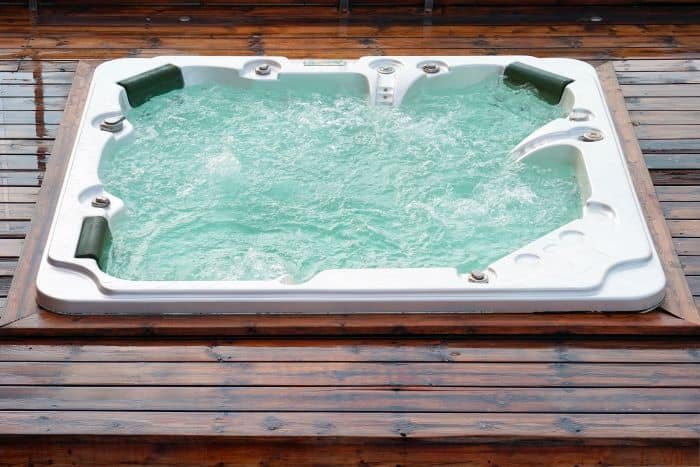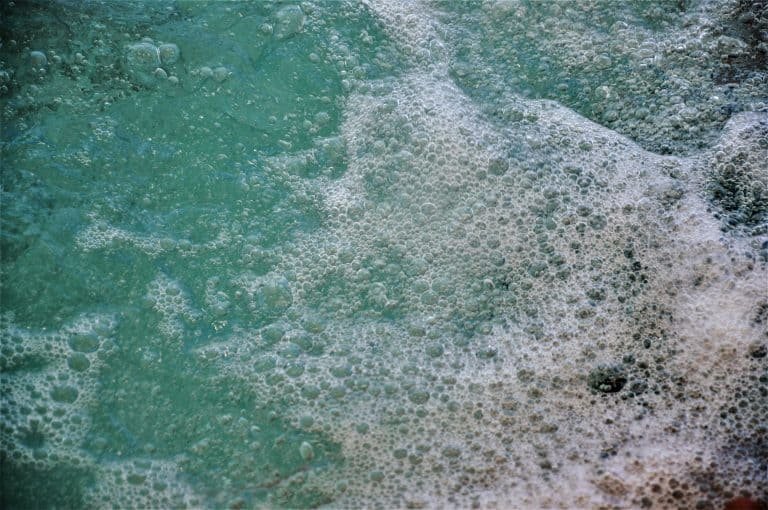How to Convert a Hot Tub to Salt Water? (Step by Step)

If you’ve wound up on this article chances are you are curious about saltwater hot tubs. You might be imagining a hot tub with the equivalent of ocean water stinging your eyes and leaving a bad taste in your mouth, but that’s not what a saltwater hot tub actually is.
People switch to saltwater hot tubs to enjoy a more refreshing and gentle quality of water, with very low maintenance required. If you already own a hot tub that is using a chlorine or bromine sanitization method, don’t fret, you don’t have to toss it out for a salt one.
Let’s discuss the main question, how to convert a hot tub to saltwater?
You can convert a hot tub to a saltwater sanitization system in a few steps, to summarize, you will need to:
- Properly drain your hot tub
- Clean, and refill your current hot tub.
- Install a chlorinator control panel
- Make sure your water pH, alkalinity, and calcium ranges are favorable.
- Test your water to properly equate how much salt you should add.
- Add the salt.
- Power up the chlorinator.
- Soak in your new saltwater hot tub!
In this article we’ll discuss the steps to convert a hot tub to salt water and the common questions about the process. Before the end, you’ll be sitting back and soaking in your low maintenance, quality saltwater hot tub.
Table of Contents
Can a Hot Tub Be Saltwater?
Over the last decade, saltwater sanitized hot tubs have become more and more commonplace. A lot of folks don’t realize that a hot tub can, in fact, be saltwater. Sanitizing a hot tub that uses chlorine or bromine is a lot of work. The process of sterilizing a hot tub with chlorine or bromine is called Shocking.
Shocking the water will essentially:
- Reduce the amount of organic matter in your hot tub
- Disinfect the hot tub of bacteria
- Get rid of bromine or chloramine contaminants from the hot tub
- Keep the bromides active and aid in the cleanliness of your hot tub
The problem with using chlorine or bromine is that these chemicals are harsh. Sometimes after a shocking, if the pH levels aren’t adequate, you’ll have to wait 24 hours after to get into your hot tub. Additionally, many report a burning sensation in their eyes and nose from the chemicals in the hot tub water.
Chlorine levels in any hot tub should be in the 1.0 and 3.0ppm range, according to the Centers for Disease Control and Prevention.
Can Any Hot Tub Use Saltwater?
With a little patience and proper guidance, almost any hot tub can use saltwater sanitation instead of chlorine or bromine sanitation methods. You do need to consult with the manufacturer of your hot tub first to be sure. There are, in some cases, hot tubs that aren’t compatible with saltwater systems. However, they are few and far between.
When in doubt, it’s always better to double-check, so you avoid any damage to your current hot tub.
If you haven’t purchased a hot tub yet and you’re interested in a saltwater system, you can buy one manufactured with the chlorination system already installed.
The Therapeutic Origins of Salt
Over the centuries, salt has been a popular choice for medicinal purposes and it’s believed to have an array of healing properties. This could be attributed to the fact that salt contains many beneficial minerals.
In Ancient Egypt, salt was used to prevent infections, as it was known to dry out wounds and disinfect them. They also used salt for laxatives and eye ointments.
The Greeks understood the benefits salt could have on the skin, they used salt water to aid with skin diseases and to attempt to reduce freckles. They also breathed in the steam from hot saltwater, which medically we know today to help reduce symptoms of respiratory illness.
In Arabian culture, doctors began incorporating salt in their medicine recipes around 980-1037 A.D.
Western Europeans took note of Arabs and Greeks, and they started using salt to reduce pain and inflammation. They also noticed that salt could help to reduce fevers.
In the 19th century, scientists began to study salt and its positive effects. This happened more around the 1950s. This is where we see the rise in its many common uses today, such as bathing, drinking, homeopathic ability, and inhaling.
4 Benefits of Saltwater Hot Tubs
Before we walk you through converting your hot tub to salt water, let’s look at a few of the benefits of saltwater hot tubs to inform you better.
- Salt is your friend; chlorine is your enemy. Dry, irritated, and damaged skin are the common complaints many shares when they frequently use chlorine-based pools and hot tubs. People with allergies and eczema tend to suffer much more from the effects of chlorine.
So, what is it with chlorine that causes these issues?
Some folks don’t check the chlorine levels in their hot tubs or pools on a much needed and consistent basis. When chlorine combines with ammonia, sweat, oils, and urine, you get an abundance of chloramines in your hot tub. These chloramines are an irritant to anyone who uses the hot tub, they will provide a burning sensation to the skin and eyes.
Chlorine is also very dehydrating to the skin, which is why many suffer from dryness after using a pool and hot tub treated with chlorine. Chlorine actually binds to the hair and the skin; it then strips them of their natural oils. So immediately afterward, you will notice brittle hair and dry skin. This is also why many with color-treated hair notice green hues appearing.
Dr. Ana Duarte, the director of dermatology at Nicklaus Children’s Hospital in Miami, told Live Science in an interview last summer that, “Excess chlorine in the pool can sometimes also cause small amounts of vapor to come out of the water, which “can trigger [a person’s] asthma.” To reduce the effects of chlorine, it’s best to shower and moisturize immediately after Duarte advises.
How does salt help you out?
Saltwater has been proven to reduce acne, open the pores, and rid your skin of excess oil. Since it is naturally antibacterial, it will help reduce any skin infections. Opposite of chlorine, it will aid your skin in retaining moisture, it also rids the skin of dead cells to reduce itching.
- You’re going to make your wallet much happier. According to Consumer Affairs, the initial costs of saltwater-treated hot tub will send you running for the hills. However, it is just the initial cost that might scare you. The initial investment can set you anywhere from $500 to $5,000. The salt cell will also need to be replaced at least every 5 years.
On average, with a chlorine or bromine-based sanitation system, you’re looking at spending $100 monthly for test strips and the necessary chemicals. That’s $1,200 a year! It doesn’t take someone highly skilled in mathematics to understand the cost difference.
- You’re taking part in helping the environment. In certain conditions, chlorine becomes a vapor-like gas in the air. This vapor can hurt animals and humans when exposed repeatedly. It can potentially harm the immune system, blood, heart, and respiratory system.
Consider that when draining your hot tub with these chemicals, you could be posing a risk to animals and other sources of life if it’s not properly done.
- It’s just much easier for you. Saltwater generators are designed to provide a maintenance-free experience with hot tubs. They will continually release the right amount of salt regularly always to keep your hot tub sanitized. The only work that is required of you, is to check intermittently that your hot tub has the right amount of salt.
A Few Notable Cons of Having a Saltwater Hot Tub
We wouldn’t be providing a non-biased opinion if we didn’t also include some noted cons of owning a saltwater hot tub.
- Saltwater will increase your risk of corrosion. Pipes, fittings, and tubs have been known to corrode with saltwater systems. This is no surprise, as we know that salt is naturally corrosive to metals.
Heaters, Liners, and Lighting features have been known to be the first features to corrode from saltwater use in hot tubs. Experts say that as long as your salt levels remain between 2,000-3,000 ppm, you shouldn’t have any corrosion. Make sure to continually monitor the salinity levels in your hot tub.
- Saltwater hot tubs have a difficult time at low temperatures as the chlorination systems aren’t designed to work under 60 degrees Fahrenheit. Aside from some additional electrical fees from maintaining a warmer temperature year-round, this doesn’t seem to be too big of an issue to most.
- Replacing the salt cell is expensive and usually takes place every two to five years. However, it’s been reported that a salt cell’s most common average life span is a mere one and a half years.
- Although there is limited research, some have argued whether salt is better at sanitizing than chlorine. Hot tubs are damp and warm, so they breed bacteria like no one’s business. Having the best sanitation method is always crucial, so some may be wary of switching to salt if it’s not as effective.
Steps to Convert Your Hot Tub to A Saltwater Sanitation System
Now that we have gone over the benefits and reasons why you might want to convert your hot tub to a salt water system, we will walk through the process step by step.
- First, properly drain, clean, and refill your current hot tub.
When draining, you’ll need to decide if you want to use the hot tub’s spigot or a submersible pump. There are a few creative ways people choose to use their drained hot tub water. Consider watering your plants, washing your cars, or dumping the water it into a pet’s pool to avoid waste.
Always check your area’s local regulations on dumping hot tub water to be sure you comply. Some areas are not okay with hot tub water, also knowns as “gray water,” being disposed of on the ground or in the sewage.
If your hot tub contains a nice layer of biofilm, which consists of bacteria and fungi, you will need a special plumbing cleaner. You’ll also need to clean and change out the filters in your hot tub.
- Purchase a chlorinator control panel and system and install it following the included instructions.
The ControlOMatic MegaChlor DO Saltwater Chlorine Generation System has great reviews and sports a much lower price than competitors.
This system features: multiple power levels, a self-cleaning system without needing external timers, no plumbing or mechanical alterations needed, and generates up to 100 grams of pure chlorine a day. The great thing about this system is that it can also be used for pools, not just hot tubs.
- Make sure your water pH, alkalinity, and calcium ranges are favorable.
Your chlorinating system will require specific guidelines on the current water chemistry within your hot tub. You’ll need to adhere to these guidelines before turning it on. If you’re switching your current hot tub over to a saltwater system chances are you already have a chemistry test kit at home, but if not consider the following from Amazon:
Pool master 22260 5-Way Swimming Pool or Spa Water Chemistry Test Kit with Case
- Test the salinity levels and then add the salt.
You may not have known that tap water has some salinity. So, you’ll want to test the salinity levels prior to adding salt so you know how much to add. When all is said and done, you’re looking at an average of about 2,500 ppm of salinity in your hot tub.
Typically, you’ll add in 2 pounds of salt for every 100 gallons of water. You’ll want to check the guide that came with your salt chlorination system to be sure of this figure as not all systems will be the same.
You can use any pool salt in your hot tub. The most common brand is AQUASALT. If you’re looking for something more therapeutic with added benefits for your skin, many people rave about including Dead Sea Salt.
Dead Sea Salt can prove to be relieving to skin conditions like psoriasis, eczema, and acne. Many report softer and cleanlier skin after using it in their spa. Dead Sea Salt is rich in minerals such as:
- Potassium
- Sulfur
- Calcium
- Sodium
- Zinc
- Magnesium
- Bromide
- Power up the chlorinator and enjoy your new saltwater tub hot tub.
You should be able to enjoy your new hot tub as soon as your chlorination system is switched on. This is another added benefit of a saltwater hot tub. No more waiting for strong chemicals to do their magic before stepping foot into your hot tub.
In no time you’ll have friends and family members begging to come over and enjoy your saltwater hot tub spa. They’ll rave about their softer skin and hair afterward, and you’ll search for ways to force them out of your home for much-needed privacy.
If you liked this article, then please subscribe to our YouTube Channel for backyard video tutorials. You can also find us on Pinterest and Facebook.







Does anyone know if master spas has a salt water conversion kit yet for there chlorine hot tubs and swim spas?
Thanks for the comment. I would contact the manufacturer directly for the most reliable answer. Below is their phone and email contact information.
800-860-7727
customerservice@masterspas.com